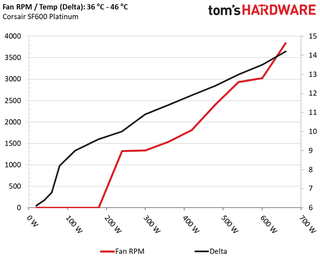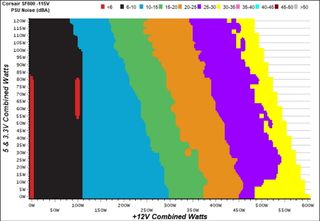Corsair SF600 Platinum PSU Review: Setting The SFX Performance Bar Higher
Why you can trust Tom's Hardware
Efficiency, Temperature & Noise
Efficiency
Our efficiency testing procedure is detailed here.
Using results from the previous page, we plotted a chart showing the SF600 Platinum's efficiency at low loads, and loads from 10 to 110 percent of its maximum-rated capacity.




This PSU's efficiency under normal loads is impressive. It's also efficient with light loads. But EVGA's SuperNOVA 650 GM turns more heads with an 80 PLUS Gold rating and notably lower price. There's a catch though, revealed in Cybenetics' efficiency rating: the 650 GM drops an efficiency level, causing it to be classified as ETA-A-. That's because of low PF readings, a sign that the PSU's APFC converter isn't particularly effective.
Efficiency At Low Loads
In the following tests, we measure the SF600's efficiency at loads significantly lower than 10 percent of its maximum capacity (the lowest load the 80 PLUS standard measures). The loads we dial are 20, 40, 60, and 80W. This is important for representing when a PC is idle, with power-saving features turned on.
| Test # | 12V | 5V | 3.3V | 5VSB | DC/AC (Watts) | Efficiency | Fan Speed | PSU Noise | PF/AC Volts |
|---|---|---|---|---|---|---|---|---|---|
| 1 | 1.180A | 0.493A | 0.473A | 0.198A | 19.482 | 71.802% | 0 RPM | <6.0 dB(A) | 0.894 |
| 12.189V | 5.076V | 3.380V | 5.045V | 27.133 | 115.34V | ||||
| 2 | 2.430A | 0.986A | 0.976A | 0.397A | 39.926 | 82.625% | 0 RPM | <6.0 dB(A) | 0.952 |
| 12.189V | 5.077V | 3.379V | 5.042V | 48.322 | 115.32V | ||||
| 3 | 3.613A | 1.478A | 1.449A | 5.039A | 59.441 | 86.295% | 0 RPM | <6.0 dB(A) | 0.975 |
| 12.189V | 5.076V | 3.379V | 5.039V | 68.881 | 115.29V | ||||
| 4 | 4.862A | 1.970A | 1.952A | 0.794A | 79.856 | 88.207% | 0 RPM | <6.0 dB(A) | 0.974 |
| 12.189V | 5.076V | 3.379V | 5.036V | 90.533 | 115.27V |
We observed very high efficiency in all four tests, while noise was non-existent thanks to the fan's semi-passive mode.
5VSB Efficiency
The ATX specification (revision 1.4), along with CEC, ErP Lot 3 2014 and ErP Lot 6 2010/2013, states that 5VSB standby supply efficiency should be as high as possible, recommending 75 percent or more with 550mA, 1A, and 1.5A of load. The PSU should also achieve greater than 75% efficiency at 5VSB under full load, or with 3A if the maximum current output on that rail is higher than 3A.
We take six measurements: one each at 100, 250, 550, 1000, and 1500mA, and one with the full load the 5VSB rail can handle.
| Test # | 5VSB | DC/AC (Watts) | Efficiency | PF/AC Volts |
|---|---|---|---|---|
| 1 | 0.100A | 0.505 | 72.767% | 0.087 |
| 5.047V | 0.694 | 115.37V | ||
| 2 | 0.250A | 1.262 | 77.471% | 0.182 |
| 5.045V | 1.629 | 115.38V | ||
| 3 | 0.550A | 2.774 | 84.599% | 0.289 |
| 5.042V | 3.279 | 115.37V | ||
| 4 | 1.000A | 5.038 | 84.389% | 0.375 |
| 5.037V | 5.970 | 115.38V | ||
| 5 | 1.500A | 7.549 | 83.618% | 0.423 |
| 5.032V | 9.028 | 115.37V | ||
| 6 | 2.500A | 12.555 | 83.328% | 0.468 |
| 5.021V | 15.067 | 115.36V |


The 5VSB circuit is highly efficient, matching the PSU's overall performance.
Power Consumption In Idle And Standby
In the table below, you'll find the power consumption and voltage values of all rails (except -12V) when the PSU is idle (powered on, but without any load on its rails), and the power consumption when the PSU is in standby mode (without any load, at 5VSB).
| Mode | 12V | 5V | 3.3V | 5VSB | Watts | PF/AC Volts |
|---|---|---|---|---|---|---|
| Idle | 12.186V | 5.075V | 3.379V | 5.047V | 7.018 | 0.518 |
| 115.4V | ||||||
| Standby | 0.048 | 0.006 | ||||
| 115.4V |


Vampire power remains low, helping the 5VSB rail achieve high efficiency under very light loads.
Fan RPM, Delta Temperature, And Output Noise
Our mixed noise testing is described in detail here.
The first chart below illustrates the cooling fan's speed (in RPM), and the delta between input and output temperature. Our results were obtained at a 36°C (96.8°F) to 46°C (114.8°F) ambient temperature.

The next chart shows the cooling fan's speed (again, in RPM) and output noise. We measure acoustics from one meter away, inside a hemi-anechoic chamber. Background noise inside the chamber is below 6 dB(A) during testing (it's actually much lower, but our sound meter’s microphone hits its floor), and the results are obtained with the PSU operating at 36°C (96.8°F) to 46°C (114.8°F) ambient temperature.

The following graph illustrates the fan's output noise over the PSU's operating range. The same conditions of the above graph apply to our measurements, though the ambient temperature is between 30°C (86°F) to 32°C (89.6°F).

An increased load on the minor rails causes the semi-passive mode to end. At least the fan profile doesn't get crazy like what we saw from Corsair's SF600 Gold.
Up to 300W load on the +12V rail, noise remains below 15 dB(A). It takes more than 480W on that rail to hit the 30-35 dB(A) range.
MORE: Best Power Supplies
MORE: How We Test Power Supplies
MORE: All Power Supply Content
Current page: Efficiency, Temperature & Noise
Prev Page Load Regulation, Hold-Up Time & Inrush Current Next Page Protection Features & DC Power SequencingStay on the Cutting Edge
Join the experts who read Tom's Hardware for the inside track on enthusiast PC tech news — and have for over 25 years. We'll send breaking news and in-depth reviews of CPUs, GPUs, AI, maker hardware and more straight to your inbox.
Aris Mpitziopoulos is a Contributing Editor at Tom's Hardware US, covering PSUs.
-
Co BIY Less than 1% efficiency difference between Gold and Platinum ? Hard to make that pay under any normal use scenario.Reply
Glad to see that they made several other improvements for the Platinum model. -
iankphone I just completed my ncase-m1 build with this. It's really good.Reply
8700K, 2080Ti. Like a boss. I'm not overclocking however (insufficient cooling for that). -
Dark Lord of Tech Reply21685936 said:Just wait now for the SF750 to get reviewed :)
Looking forward to it. I will most likely get one for my next setup. -
smitty2k1 Did you test the SF600 platinum with Vega graphics cards? I'm getting the OCP to trip on my just running the Vega 56 in turbo mode. The same thing was happening with my older Silverstone SX-650G power supply, and Silverstone confirmed that they had made an engineering change to fix the OCP tripping.Reply
It only happens in Destiny 2, no other games. I'm curious if this is a widespread issue, or something else with my system. It seems the Vega cards are tough on PSUs.